




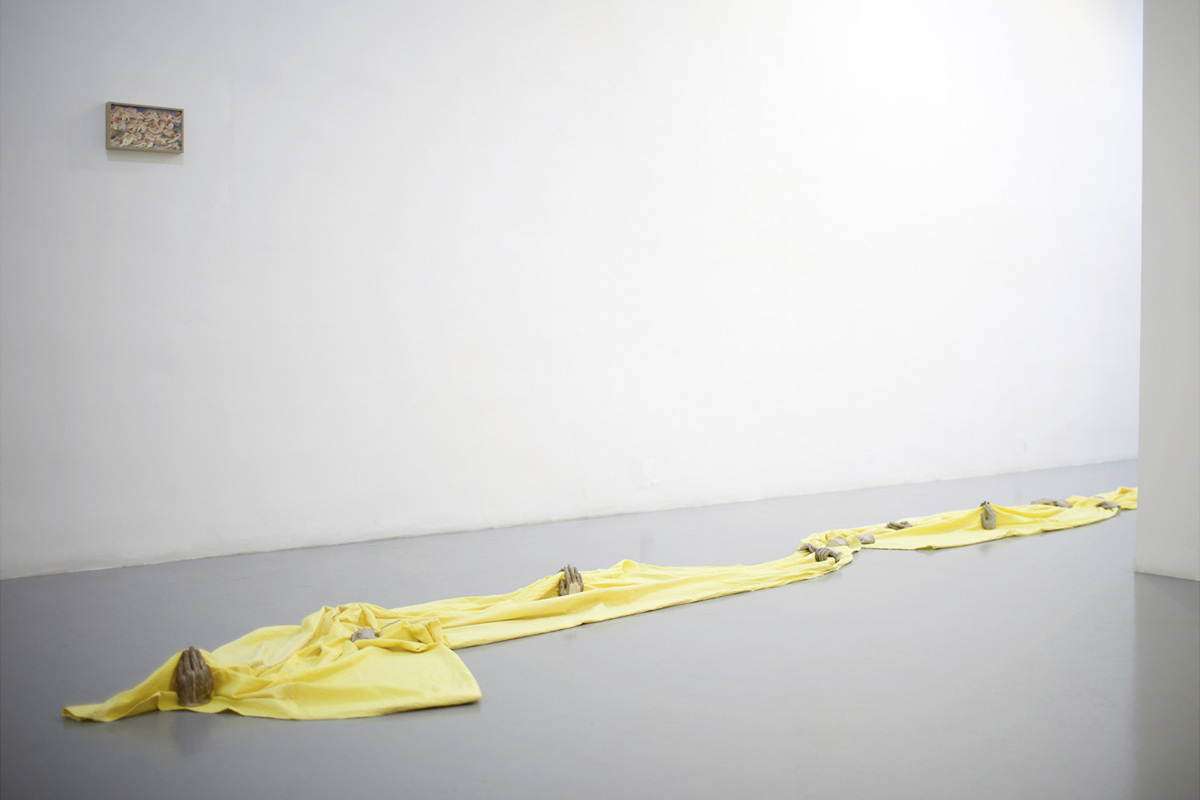



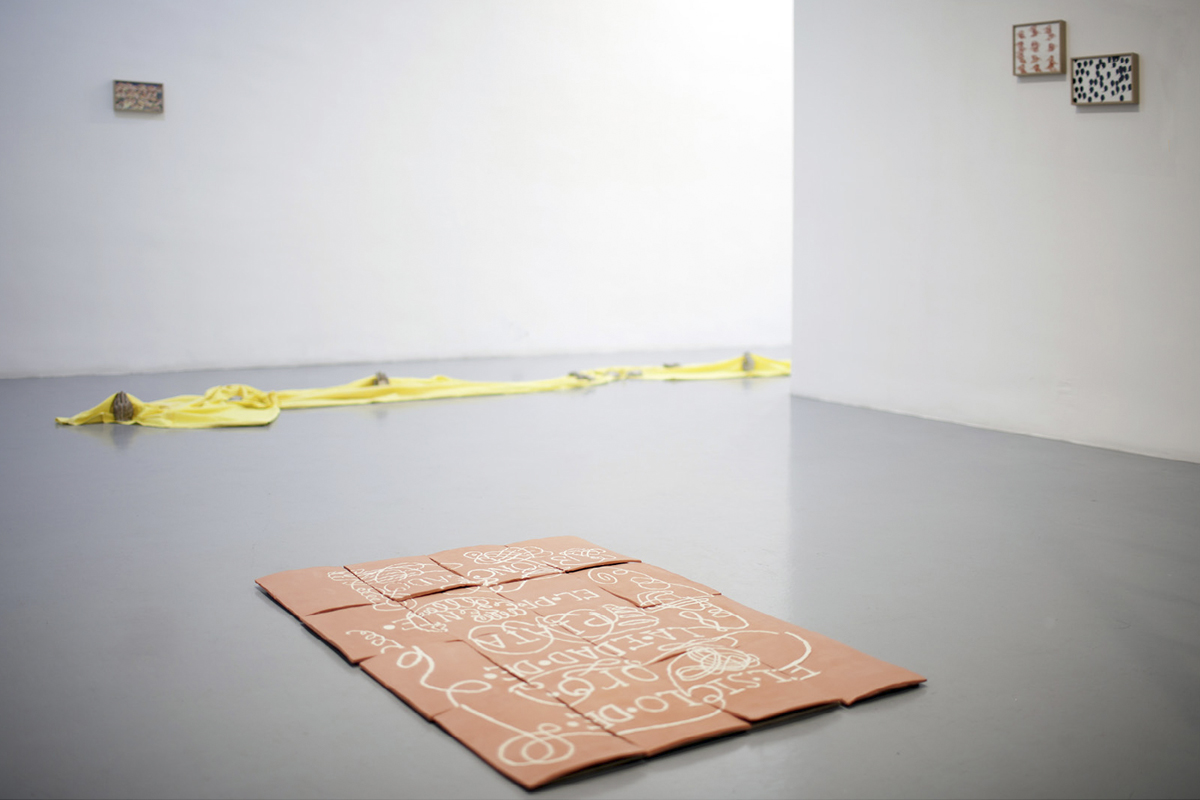
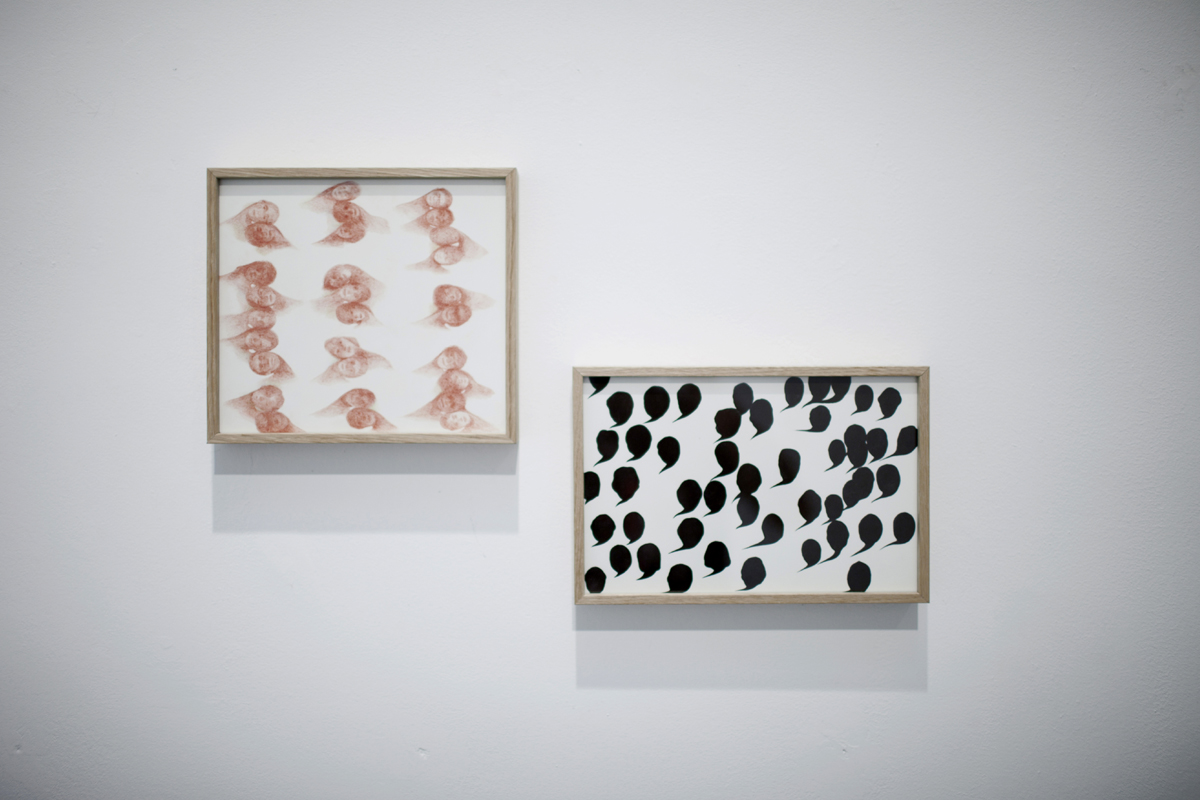







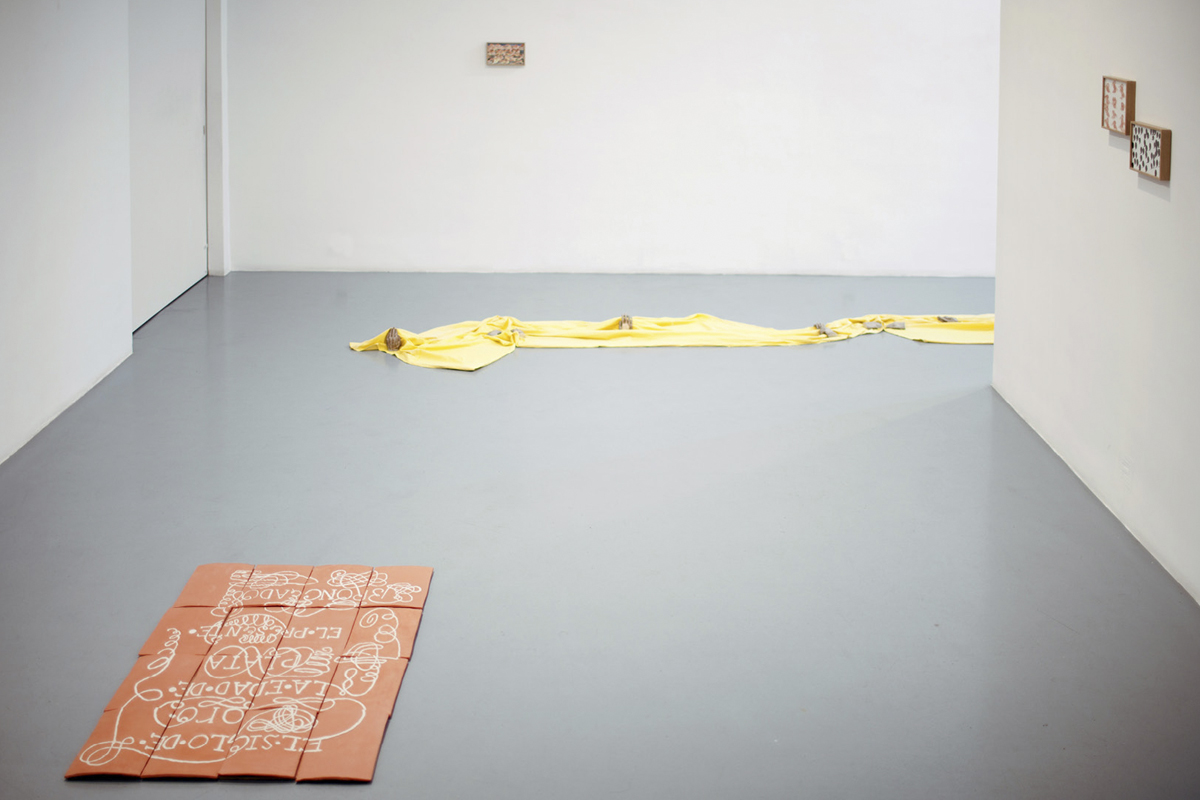



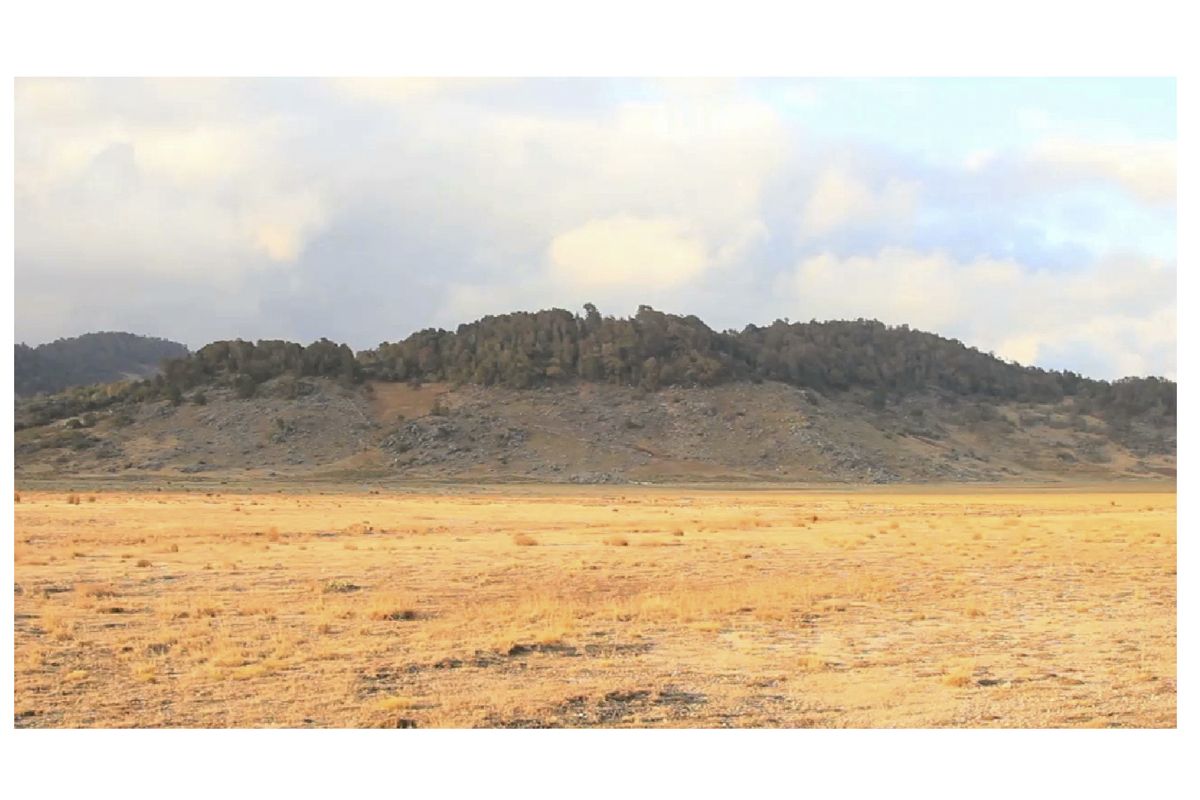



Tambo_Hellen Ascoli_Patricia Esquivias_Rita Ponce de León_Curated by Andrea Pacheco González_05/14/21_07/30/21_dossier
To perceive texture is never only to ask or know What is it like? or even just How does it impinge on me?
Textural perception always explores two other questions as well: How did it get that way? and What could I do with it?
Eve Kosofsky Sedgwick
It is possible to think of the practice of many artists as a whole, as a body or -in consonance with the allegory this exhibition proposes- as a path: sometimes straight, sometimes winding; at times easy, at other times lined with mud. Each piece or project an artist undertakes could be understood as a temporary stage along an extended journey. In this exhibition proposal, the paths set out upon more than a decade ago by Hellen Ascoli (Guatemala, 1984), Patricia Esquivias (Venezuela, 1979) and Rita Ponce de León (Peru, 1982), come together in Galería Ángeles Baños through a set of mostly new works, where materials, textures and affects coincide along a concordant direction.
In the Inca Empire of Tawuantinsuyu, a tambo was part of a sophisticated system of communication that allowed the entire territory to be connected through messengers, the chasquis, who ran with messages and gifts over a massive network of paths. The tambos functioned as inns where these messengers could eat and rest after a day’s journey. They were also used to store goods, provide shelter for animals and, in some cases, as administrative centres. Those polyvalent architectures are the inspiration for this encounter of practices, where manual and even corporeal practice, understood as working instruments, take on great importance. We refer to practices which include elemental techniques and materials such as clay or canvas; at the same time, they set up collaborative methodologies, as they bring together a diversity of abilities and skills, in processes that continue to link us with ancestral technologies and practices.
Encuentro [Encounter] (2014), the video that Hellen Ascoli presents in the exhibition, shows a body wrapped in some kind of cloth, rolling along a line parallel to the horizon, with no other company than its own shadow. The bundle enters into the frame from the right, and for almost four minutes moves along a linear path until disappearing to the left. The process then begins again. In the background the Sierra de los Cuchumatanes mountain range in Guatemala is seen crowning a hypnotic scene, which is unsettling despite the placid landscape. Using the body as a tool of knowledge, for a number of years Hellen Ascoli has explored the sensorial possibilities of objects, textures and materials. In this project she pays special attention to the proprioceptive sense, which allows the brain to know the position of the body through the nervous terminations of muscles and joints. Thanks to the pressure of a surface of the body, our proprioceptive capacity allows us to situate ourselves in relation to space. By rolling along the ground, Ascoli questions the possibility of identifying a territory and the place one occupies in it. In a moment of heightened discomfort, the artist chose to roll across a flat plain found amidst these mountains, the highest in Guatemala, so as to respond to the question that tends to go along with every journey: What am I doing here?
In (o)ver (o)ver II (2021), Ascoli also uses her body as an instrument, although in this case as part of the machinery producing her textile pieces. As she explains: “Every piece of cloth is intimately related to the body that uses it; its weave is the width of my hips, its warp my height, its patterns spaced out by the threads I hold in my hand and by the tension I feel on my fingertip as I feed the loom.” Cloth has been one of the artist’s favoured travelling companions. This is particularly so with the research she has carried out in recent years on weaving techniques in Guatemala, featuring the backstrap loom, a traditional pre-Hispanic device used by various craft communities in Mesoamerica. The piece (o)ver (o)ver II has no beginning and no end; its starting and finishing point is one and the same. Its graphic patterning is composed of woven lines, interwoven paths, running in parallel like ploughed furrows in a farmer’s field, made into a single cloth by a body-compass that seems to guide us along an unending path.
Alexandra con Rodrigo con Andrea con Lia con Ángeles con Emilio con Gustavo con Martín con Rita (2021), the installation presented by Rita Ponce de León in this exhibition, was produced a few months ago in Mexico, amidst the complexity and uncertainty brought on by the current pandemic. The names appearing in the piece’s title correspond to some of the people who made it possible, constituting an authentic human chain running from Mexico City to Badajoz, Spain. At the same time, it recalls the transcendent role of contemporary artistic production in collaborative networks, both in terms of their purely technical aspects and their affective features. Rita has dedicated a good part of her work to inquiries into the possibility of giving form to human bonds. Sometimes she calls together a group of individuals to play with or hold onto pieces of cloth, while for other works she creates sinuous spaces we can move through on our own, as we experience chance encounters of a pleasantly ephemeral nature. She also uses drawing to indicate contacts, physical touches and symphonic experiences that may combine to compose a totality of bodies in space.
In this installation, created especially for this exhibition, the artist proposes a visual metaphor of what could be considered the greatest privation of the present moment: affective flow. A yellow piece of cloth runs through fragile ceramic fingers; a soft, loose texture running through various sets of hands, which in turn seem to suggest a path to follow. What does touch indicate? Does it point to some sort of path? In this sense we may ask, in turn, about where it is leading us. The desire to touch and be touched assumes the form of a path, or river of cotton dyed with turmeric, moving through unmoving fingers. The impossibility of grasping this cloth does not however impede the affective character of the choreography proposed by the artist. To imagine touching could be a way of feeling; there is something in the texture that points to an affect. As feminist thinker Eve Kosofsky Sedgwick has affirmed (in her 2003 Touching Feeling), texture and affect are part of the same whole.
Patricia Esquivias presents Folklore II, a newly-produced work that continues along the trajectory marked out by two previous projects: the video Folklore 2 (2008); and El saber acabar [Knowing How to Finish] (2009), which was shown in the Casa Museo Lope de Vega as part of the exhibition Mutaciones: Intervenciones artísticas en museos. The artist takes the text El siglo de oro La edad de plata El presente bronceado [The Golden Age The Silver Age The Bronze Suntanned Present], previously printed on an esparto mat, and transfers it onto a piece of ceramic. She thus produces a technically useless object, with no functionality whatsoever: a clay carpet. In line with other pieces by the artist, the work once again puts into tension traditional craft techniques used in the production of decorative objects. Carpets, tapestries, wall and floor tiles, plaster and cladding have all aroused the artist’s interest, in particular in terms of their historical function as building materials and for their role in storytelling. With this dysfunctional floormat, Patricia perverts the essential vocation of the decorative arts with a gesture that is rough and austere. Yet at the same time she probes the emotional archaeology of these forms, paying attention to the pulsations and agencies that objects come with.
El siglo de oro La edad de plata El presente bronceado also deals with a question that the artist had posed in earlier work, related to the identity and symbols associated with a given community. The work connects two historical moments separated by four hundred years of history, in a way that is entirely arbitrary and charged with irony; the sun appears as a connecting sign between 16th century Spain (the empire where the sun never set) and the 20th century (Spain, Everything Under the Sun). Adding to the sarcasm, and once again seduced by a gesture that is at once historical and ornamental, she uses the Spanish calligraphic tradition of the 1500s. The pieces take us from the Golden Age, with the sacking of the Transatlantic colonies of Philip II, to the bronze suntanned age of the present on the beaches of Benidorm, with its golden performativity summed up by a single face, that of singer Julio Iglesias.
The symbolic “Tambo” inferred by this exhibition brings together the work of Hellen, Rita and Patricia as a visual translation of the path taken by each one of them until the present. The gallery operates as one of those ancient constructions, occupied only temporarily. It features spaces that are liminal, transitory and hybrid, making it possible for the projects -and these paths-to find rest, while also opening up the possibility of shared reflection. We are invited to delve more deeply into the narrative aspect of these works. These images, forms, textures and affects provide us with stories of journeys underway, of traversed geographies. They are works which, no matter how we look at them, correspond to the memory of an itinerary.
Andrea Pacheco González, April 2021
With the collaboration![]()
With the support![]()
